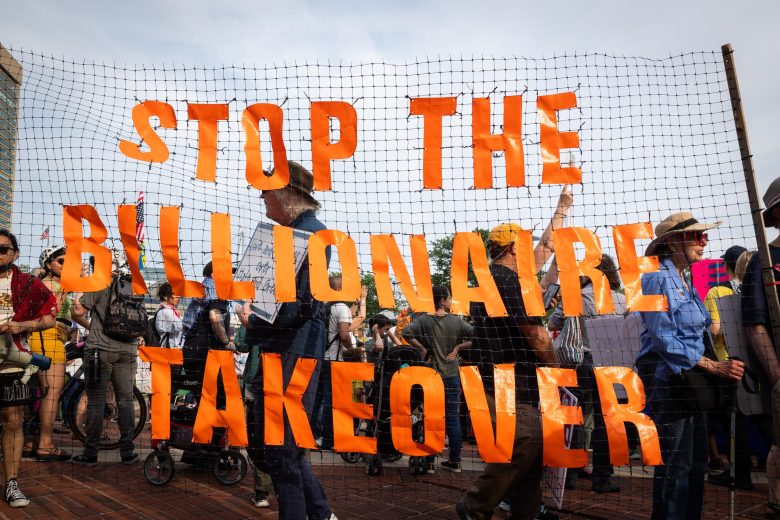Thousands of Baltimoreans flooded the streets downtown on May 1 to demand a future defined by justice, hope, and investment in the public good — not billionaire control. Organized under the banner #MayDayStrong, the citywide mobilization brought together labor unions, students, immigrant rights organizers, and community groups calling for bold action to defend democracy and human dignity.
“Trump and his cabinet are the richest cabinet in U.S. history,” said Anna Evans-Goldstein, an organizer of the May Day demonstration in Baltimore. “They’re taking rights away from working families. They’re taking funding away. They’re taking jobs away. They’re taking our students’ futures away. And we’re here to come together in solidarity. And Baltimore is saying hell no to that.”
Organizers estimate that tens of thousands of people took part in 900 May Day actions across the U.S., demanding a future that puts families over fortunes, public schools over profits, and healthcare over hedge funds.
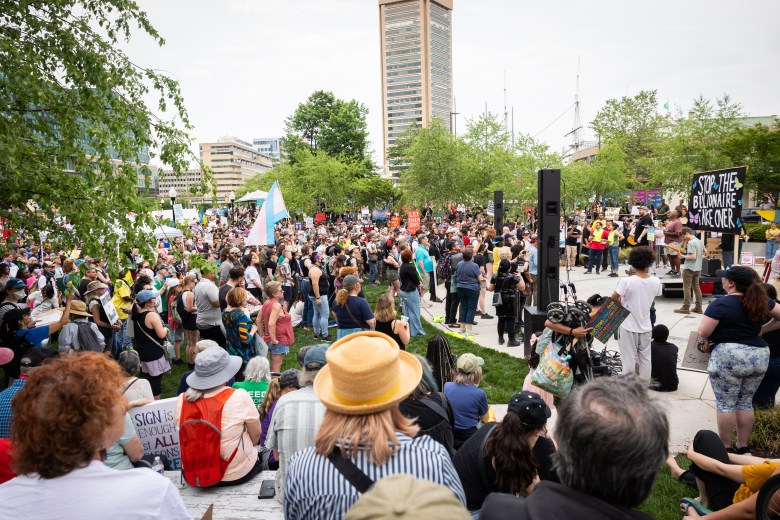
While May Day traces its roots back to the bloody 19th-century fight for the eight-hour workday and has long held deep significance for the labor movement, commemorations in Baltimore in recent years have been relatively small. This year’s action marked a notable resurgence — both in size and in the wide range of issues represented.
Baltimore’s May Day protest was the culmination of months of local organizing against Trump administration policies. From the devastating impacts of mass ICE detentions and funding cuts tied to Project 2025 to attacks on academic freedom, the march reflected a city-wide response to policies that demonstrators argued threaten marginalized communities and democracy itself.
The action was endorsed by more than 50 local organizations, including unions like 1199 SEIU, the Baltimore Teachers Union, AFSCME Council 3, and grassroots groups like CAIR and the Trans Rights Advocacy Coalition. Attendees carried signs reading “Fund Families, Not Billionaires,” “Hands Off Our Students,” and “Ceasefire Now.”
Organizers passed around clipboards and encouraged participants to sign up to join local efforts such as the Baltimore Rapid Response Network, which mobilizes residents to support communities in crisis and offers political education, and the Free State Coalition, which is helping organize weekly protests — every Monday outside the ICE offices downtown and every Saturday at the Tesla dealership in Owings Mills.
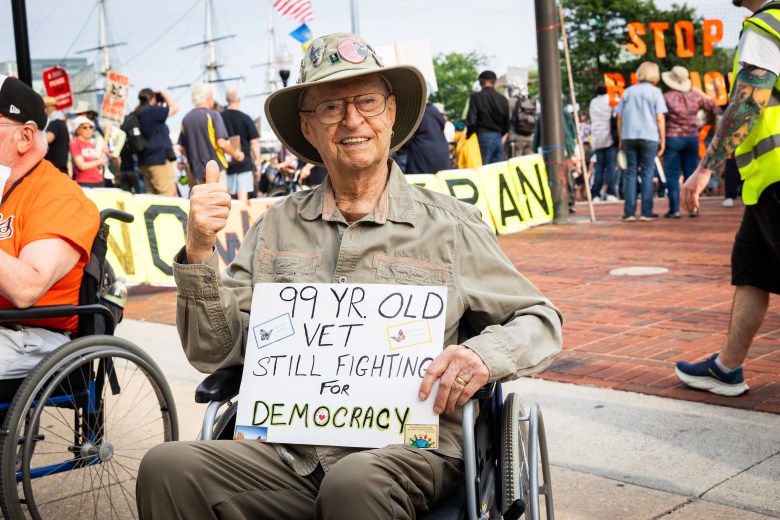
Throughout the afternoon, dozens of speakers representing many of the endorsing organizations took the stage and echoed those calls, urging attendees to stay engaged and continue to organize in defense of marginalized communities.
One of the most raucous rounds of applause came for 16-year-old Zion Parran, a student at Baltimore City College, who urged her peers to continue to lead the fight for justice.
“We believe that as students with voices… we should be able to stand up and fight for those things,” she said. “You should make demands on the city, on the state, or this country… because this is not where our story ends.”
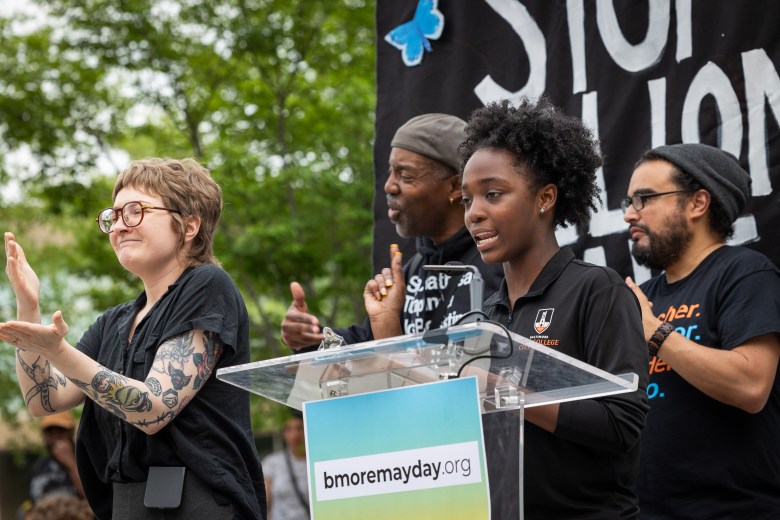
For many, the protest was also a response to attacks on marginalized communities. Hannah Pursley, who lost her job working with an organization that served immigrant children in March, said that’s exactly why she showed up.
“The overall message is that all these issues are intertwined — worker issues, the genocide in Palestine, immigration reform,” she said. “These are all connected. And so we’re all here as neighbors, as community members, to show up and show out together.”
Many speakers addressed the Trump administration’s attempted deportation of dozens of international students who vocally opposed U.S. support for Israel.
“I think everyone should be afraid that our First Amendment rights are in jeopardy right now,” said Evans-Goldstein. “Especially students being disappeared with no due process. It’s something that should concern us all. We are also always concerned about where our country is spending their money. We think that those dollars that are being sent to Israel to drop bombs could be spent on working families here in the States.”
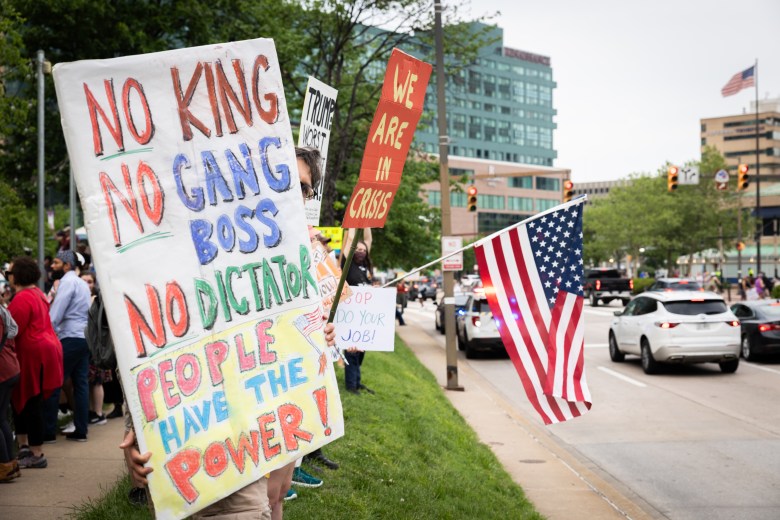
Seven different feeder marches launched from locations across the city — including Penn Station, Rash Field, the Enoch Pratt Library, and Camden Yards — each highlighting a distinct frontline struggle. Hundreds took part in each, rallying under banners like Hands Off Our Students & Faculty; the 99 vs 1 March; the Cultural Workers March; the March for Palestine; the Family & Kids March for Justice; the March for Migrant Justice; and the March for Worker Justice. As they converged at McKeldin Plaza in the Inner Harbor, the crowd swelled and their chants merged into one.
“It’s just really important that as many of us gather together on this day for workers and recognize the genocide in Gaza and how we are all connected people,” Jessica Smith, who attended with her 11-year-old son, said. “As a human being and as a parent, it’s important to take a stand when things are definitely wrong. We discussed coming down and participating in one of the rallies. He chose the Palestine one. We talked about it, and he feels really strongly about it too. “
In the original tradition of May Day, this year’s marchers rallied against rising inequality, state violence, and what they described as a growing authoritarian threat from the Trump administration. Many referenced recent efforts to criminalize campus protests, cut social services, and grant even more power to the wealthy.
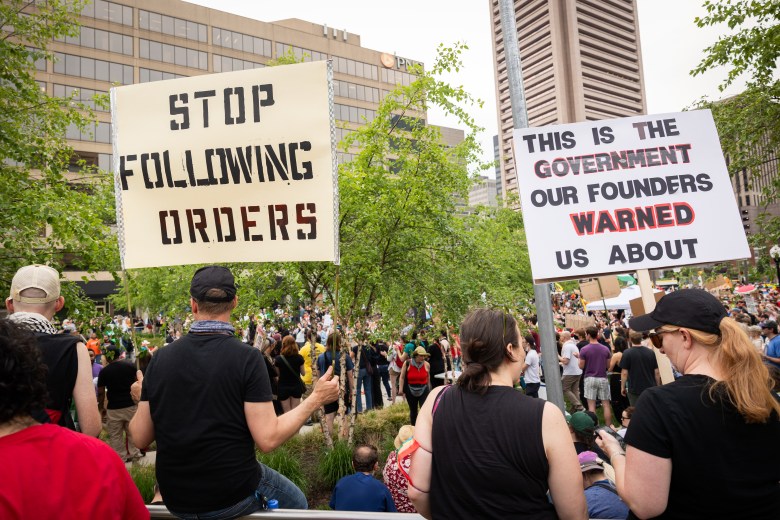
Aimée Pohl, who also marched with her children, said she came because the consequences of far-right policies are already hitting close to home. “Migrant kids, public school kids, trans kids — they are the ones we’re here to protect,” she said.
“This is just the beginning. A lot of organizing has to happen. This is the moment where we’re rising up and saying we’re here and we’re not alone.”

